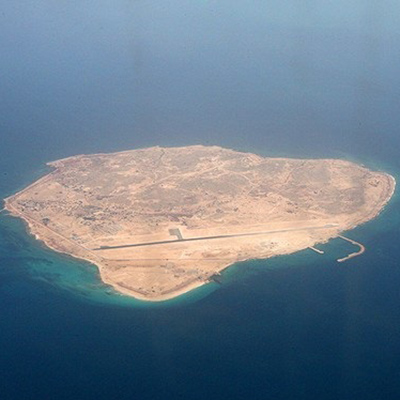Sites
Greater Tunb Island
Written by: Emad Ezatabadi,
Translated by: Hadi Qorbanyar
76 Views
Greater Tunb is an Iranian island in the Persian Gulf. The question of sovereignty over this island was among the pretexts used by Saddam Hussain to justify Iraq’s invasion of Iran.
Greater Tunb Island belongs to Abu Musa County, Hormozgan Province.[1] It covers an area of approximately 11 square kilometers and lies about 180 kilometers south of Bandar Abbas. “Tunb” in Dari Persian means “hill”,[2] referring to the western and northwestern elevations that give the island a mound-like appearance.[3] The island’s climate is arid maritime, with maximum and minimum recorded temperatures of 45°C and 5.8°C, respectively.[4] Average annual rainfall is 126 mm, and groundwater resources are extremely limited.[5] Vegetation consists mainly of kert (acacia nilotica), kahur (Albizia lebbeck), konar (Ziziphus spina-christi), and Gaz (tamarisk).[6] Most of the island’s inhabitants are government employees and members of the Iranian armed forces. According to the 1996 census, the population numbered 637, with most residents engaged in military and construction-related occupations.[7]
Iranian sovereignty over the island dates back to ancient times. Except a brief period during the rule of the Median king Cyaxares until the fall of the Sassanian dynasty, the island remained under Iranian control.[8]
During the reign of Umar ibn al-Khattab, the island became part of the early Islamic Caliphate, but under Abu Bakr Saad ibn Zangi, Atabeg of Fars, it was restored to Iranian authority. This continued until the arrival of the Portuguese in 1507. In 1625, Imam Quli Khan expelled the Portuguese from the Persian Gulf on the orders of Shah Abbas I, and Iranian control over the Greater Tunb was restored.
Following the fall of the Safavid state, the British East India Company established a presence on the island. In 1727, Nader Shah Afshar reasserted Iranian sovereignty.[9] After his death, Karim Khan Zand’s policy of tolerance allowed the Qasimi sheikhs of Ras al-Khaimah to take de facto possession of the island.[10]
To safeguard the security of Indian maritime routes—which served British interests—against the naval conflicts involving the Qawasim and the Bani Yas tribes active along the coasts of present-day UAE, British authorities deemed intervention necessary. This decision was further prompted by Iran’s neglect of its southern shores, which had enabled increased state presence in the region and posed a growing threat to British interests. Accordingly, in 1820, the British political resident in the Persian Gulf, Hennell, was instructed by the Governor of Bombay to establish a demarcation line—later known as the “Hennell Line”—to serve as Iran’s maritime boundary with the Emirati sheikhs.
As a result, Greater Tunb, Abu Musa, and Sirri were recognized as parts of Iranian territory.[11] Nevertheless, in 1903, the British occupied Greater Tunb and several other islands.
Finally, in 1971, Muhammad-Reza Shah Pahlavi reestablished Iranian sovereignty over the three islands—Greater Tunb, Lesser Tunb, and Abu Musa—in exchange for relinquishing Iranian sovereignty over Bahrain.[12]
One of the issues raised by Saddam Hussain before launching the war against Iran was the demand for Iran’s unconditional withdrawal from Greater Tunb, Lesser Tunb, and Abu Musa.[13] Since the president of the United Arab Emirates openly supported Iraq’s position regarding the islands, Iran responded by reinforcing its military posture in the region. The First Naval District of the Iranian Army Navy, backed by the Second District, strengthened its defensive positions to ensure the protection of Greater Tunb, Lesser Tunb, and Abu Musa.[14]
Prior to the outbreak of war, Saddam launched an extensive propaganda campaign emphasizing Arab nationalism and claiming Arab ownership of the three islands, in an effort to motivate his forces for a major offensive against Iran.[15] He asserted that the islands were “Arab territory”[16] and should be returned to the states on the southern shores of the Persian Gulf.[17]
After the war began on September 22, 1980, Iraq pursued diplomatic efforts alongside its military aggression to challenge Iran’s sovereignty over the three islands. Therefore, on October 31, Iraqi Foreign Minister Sadun Hammadi informed the UAE that Iraq would support any move by the Emirates to reclaim the islands.[18] Saddam also declared that as long as Iran held the islands, the danger of war—and future wars—would persist until Arab sovereignty over them was restored.[19] On December 12, 1980, the UAE sent a memorandum to UN Secretary-General Kurt Waldheim, claiming that Iran had “occupied” the islands in 1971 and reiterating its insistence on their return.[20]
Inside Iran, President Abolhassan Banisadr proposed a plan to end the war, according to which a third party would be stationed in territories occupied by Iraq, after which negotiations with the Persian Gulf Arab states regarding the three islands could take place. In practice, this plan delayed Iranian operations, including the effort to break the siege of Abadan.[21] However, the success of Operation Thamen al-Aemmah (as) disproved Banisadr’s plan. What ultimately shifted the Persian Gulf Arab states’ position regarding the islands was the liberation of Khorramshahr. Following this turning point, the Persian Gulf Cooperation Council issued a statement on the 31st of May 1982. While supporting an end to the war, the Council announced that Iraq was prepared to withdraw to its own borders. On the one hand, the Arab states sought to prevent further Iranian advances, and on the other, they feared the possibility of Iranian retaliation. For this reason, the statement avoided overt support for Iraq and instead urged Iran to respond positively to initiatives aimed at ending the war.[22]
In 1983, Iraq received five Super Étendard aircraft from France along with Exocet missiles to prevent Iran from exporting oil. In response, Iran threatened to close the Strait of Hormuz if its oil tankers were attacked. Before the delivery of these aircraft, Iran reinforced its military positions on Greater Tunb and the other Persian Gulf islands, conducting reconnaissance flights and preparatory support measures to enable the potential closure of the Strait. Consequently, Sultan Qaboos, the King of Oman, warned the United States that Iran is capable of closing the Strait of Hormuz.[23]
After the end of the Iraq-Iran war, the United Arab Emirates continued to assert claims over the Iranian islands in the Persian Gulf. In 1992, during negotiations in Abu Dhabi regarding the three islands, Iran stated that these islands would remain permanently under its sovereignty. Tehran further emphasized that it would not, under any circumstances, enter into negotiations with any party over their sovereignty.[24]
Given that Greater Tund is located near the Strait of Hormuz in the deepest part of the Persian Gulf, it plays a key role in controlling maritime traffic. Ships transiting the Strait of Hormuz inevitably pass near one of Iran’s three islands. This geographic reality underscores Iran’s maritime sovereignty over the Persian Gulf.[25]
[1] Golverdi, Isa, Joghrafiya-ye Jazayer-e Irani-ye Khalij-e Fars (Jazayer-e Bumusi, Tonb-e Bozorg, Tonb-e Kuchak) (Geography of the Iranian Islands in the Persian Gulf: Abu Musa, Greater Tunb, Lesser Tunb), Tehran, Sazman-e Joghrafiyayi-ye Niruhaye Mosallah, 1381, p. 160.
[2] Afshar Sistani, Iraj, Nam-e Daryaye Pars va Daryaye Mazandaran va Bandarha va Jazireha-ye Irani (The Name of the Persian Gulf, Caspian Sea, and Iranian Ports and Islands), Tehran, Kashtirani-ye Valfajr 8, 1376, p. 126.
[3] Golverdi, Isa, Ibid., Pp. 161–162.
[4] Ibid., p. 166.
[5] Ibid., Pp. 177–178.
[6] Ibid., Pp. 181–182.
[7] Ibid., Pp. 189–192.
[8] Arab-Esmaeili, Mahmoud & Soleiman Ghasemian, Jazayer-e Segane-ye Irani: Pishine-ye Tarikhi-ye Abu Musa, Tonb-e Bozorg va Tonb-e Kuchak (The Three Iranian Islands: Historical Background of Abu Musa, Greater Tunb, and Lesser Tunb), Tehran, Kanoon Andisheh-ye Javan, 1395, Pp. 47, 49.
[9] Arab-Esmaeili, Mahmoud, Ibid., Pp. 54–56, 64–65, 69.
[10] Golverdi, Isa, Ibid., p. 195.
[11] Arab-Esmaeili, Mahmoud, Ibid., Pp. 79–82.
[12] Ibid., Pp. 113, 160.
[13] Moradpiri, Hadi & Mojtaba Sharbati, Ashnaei ba Olum va Maaref-e Defa Muqaddas (Introduction to the Sciences and Knowledge of the Sacred Defense), Tehran, SAMT, 11th Ed., 1392, p. 71.
[14] Savadkoohi, Shahrokh, Eqdamat va Natayej-e Amaliat-e Niruye Daryayi-ye Artesh-e Jomhuri-ye Eslami Iran dar Moqabele ba Tajavozat va Modakhelat-e Araq va Nirohaye Faramonteqei dar Khalij-e Fars (Actions and Results of the Iranian Navy in Confronting Iraqi and Non-Regional Powers’ Interventions in the Persian Gulf), Tehran, DAFOS, 1397, p. 249.
[15] Lotfollahzadegan, Ali-Reza, Ruzshomar-e Jang-e Iran va Araq, Vol. 5, Huveyzeh; Akharin Gamhaye Eshghalgar: Zamingir Shodan va Tavaqof-e Kamel-e Doshman (Chronology of the Iran-Iraq War, Vol. 5: Huveyzeh; Last Steps of the Occupier: Immobilization and Complete Halt of the Enemy), Tehran, Sepah Pasdaran-e Enqelab-e Eslami, Markaz-e Motaleat va Tahqiqat-e Jang, 4th Ed., 1390, p. 544.
[16] Savadkoohi, Shahrokh, Ibid., p. 74.
[17] Moradpiri, Hadi, Ibid., p. 70.
[18] Lotfollahzadegan, Ali-Reza, Ibid., p. 85.
[19] Ibid., p. 166.
[20] Ibid., p. 419.
[21] Izadi, Yadollah, Ruzshomar-e Jang-e Iran va Araq, Vol. 15, Azadsazi-ye Sarzamiha-ye Iran, Gam-e Aval: Amaliat-e Thamen al-Aemmah Shekast-e Mohasere-ye Abadan, Nakami-ye Monafeqin dar Barandazi-ye Nezam (Chronology of the Iran-Iraq War, Vol. 15: Liberation of Iranian Territories, Part One: Operation Thamen al-Aemmah (as) against the Siege of Abadan, Failure of the People’s Mojahedin Organization in Overthrowing the Iranian State), Tehran, Sepah Pasdaran-e Enqelab-e Eslami, Markaz-e Asnad va Tahqiqat-e Defa Muqaddas, 1396, p. 1148.
[22] Habibi, Abolqasem, Ruzshomar-e Jang-e Iran va Araq, Vol. 19, Azadsazi-ye Khorramshahr, Payan-e Royaye Tajzie-ye Iran (Chronology of the Iran-Iraq War, Vol. 19: Liberation of Khorramshahr, End of the Dream of Partitioning Iran), Tehran, Sepah Pasdaran-e Enqelab-e Eslami, Markaz-e Asnad va Tahqiqat-e Defa Muqaddas, 1397, Pp. 701–703.
[23] Lotfollahzadegan, Ali-Reza & Iraj Hemmati, Ruzshomar-e Jang-e Iran va Araq, Vol. 28, Nokhostin Amaliat-e Bozorg dar Shomal-e Gharb (Chronology of the Iran-Iraq War, Vol. 28: The First Major Operation in the Northwest), Tehran, Markaz-e Asnad va Tahqiqat-e Defa Muqaddas, 1396, p. 744.
[24] Arab-Esmaeili, Mahmoud, Ibid., p. 183.
[25]Amiri, Ali & Hojjat Naderi, Naghsh-e Jazayer-e Seganeh dar Seyadat-e Daryayi-ye Iran dar Khalij-e Fars (The Role of the Three Islands in Iran’s Maritime Sovereignty in the Persian Gulf), Nashrieh Tahqiqat-e Karbordi Olum-e Joghrafiyayi, Year 20, No. 58, Paeez 1399, p. 341.





